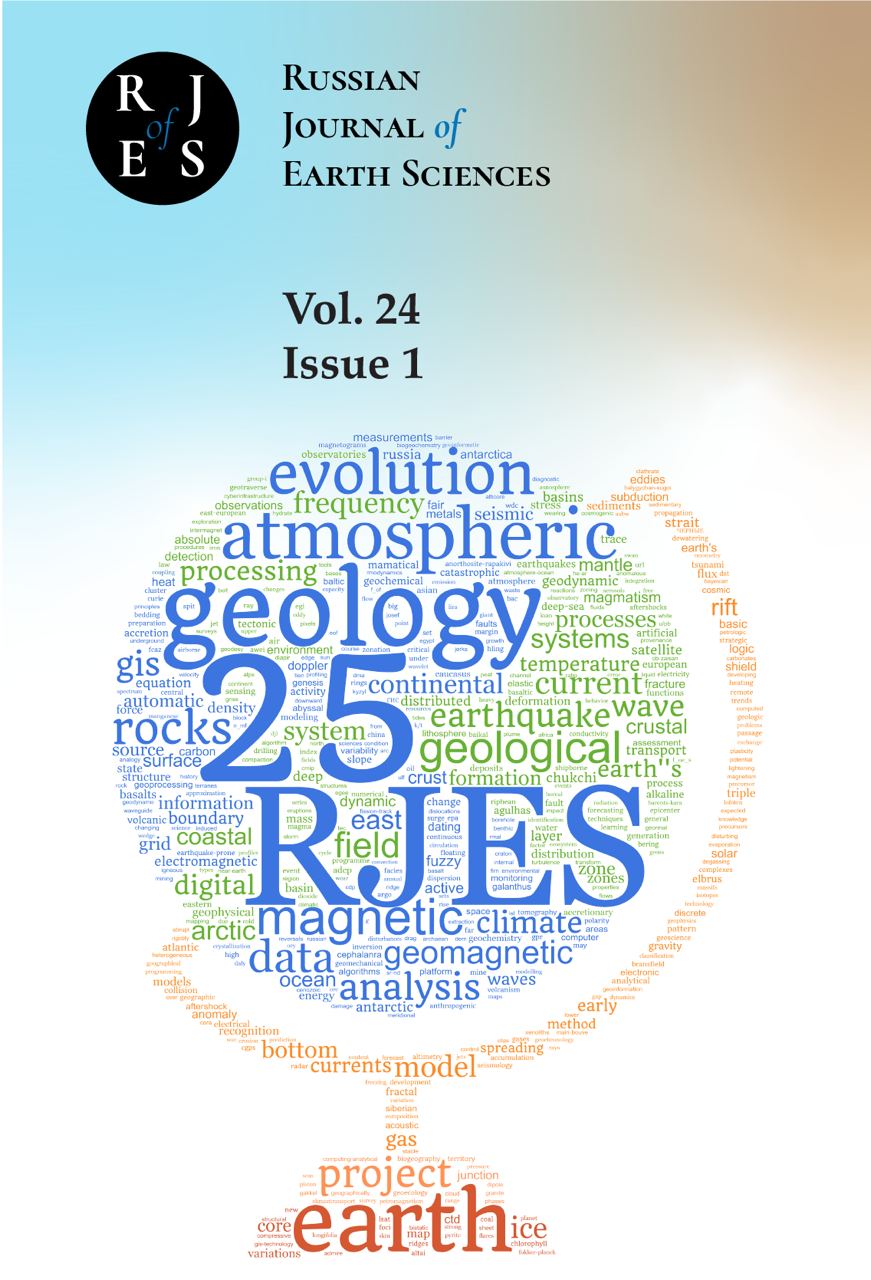Russian University of Transport (MIIT) (Scientific Supervisor)
employee
Russian Federation
UDC 004.9
UDC 55
UDC 550.34
UDC 550.383
CSCSTI 37.01
CSCSTI 37.15
CSCSTI 37.25
CSCSTI 37.31
CSCSTI 38.01
CSCSTI 36.00
CSCSTI 37.00
CSCSTI 38.00
CSCSTI 39.00
CSCSTI 52.00
Russian Classification of Professions by Education 05.04.03
Russian Classification of Professions by Education 05.00.00
Russian Library and Bibliographic Classification 26
Russian Trade and Bibliographic Classification 63
BISAC SCI SCIENCE
Geoinformatics is a scientific discipline that focuses on natural, technical, and socioeconomic spatial systems studied through computer modeling of localized objects and phenomena. The main goals of geoinformatics as a science are visualization, localization, and decision-making regarding spatial transformations of the environment. The structure of geoinformatics includes such sections as geosystem modeling, spatial analysis, and applied geoinformatics itself. The development of technologies for collecting, storing, converting and exchanging spatial and temporal data has led to the rapid development of GIS technologies and the emergence of a wide variety of industrial GIS aimed at processing geodata in order to make informed decisions. Currently, geoinformatics in many industries is perceived as a geoinformation industry, which implies the presence of its own equipment, the development of commercial software products such as GIS, a staff of experienced expert analysts and the organization of marketing. The paper highlights three of the most pressing problems faced by researchers in the field of geoinformatics over the past two decades: interoperability, digital transformation, and geodata fusion. The characteristic features of these problems and some aspects of their solution are considered.
geoinformatics, GIS, geointeroperability, digital transformation, geodata fusion
1. Al-Bakri, M., and D. Fairbairn (2012), Assessing similarity matching for possible integration of feature classifications of geospatial data from official and informal sources, International Journal of Geographical Information Science, 26(8), 1437-1456, https://doi.org/10.1080/13658816.2011.636012.
2. Ciuonzo, D., and P. Salvo Rossi (2014), Decision Fusion With Unknown Sensor Detection Probability, IEEE Signal Processing Letters, 21(2), 208-212, https://doi.org/10.1109/LSP.2013.2295054.
3. Dulin, S. K., N. G. Dulina, and P. V. Yermakov (2014), Intellectualization of access to geodata based on semantic geointeroperability, Journal Information-measuring and Control Systems, 12(8), 41-47 (in Russian). EDN: https://elibrary.ru/SWALSF
4. Dulin, S. K., N. G. Dulina, and D. A. Nikishin (2016), Problems of maintenance of semantic geointeroperability and coordination of understanding of geodata semantics, Systems and Means of Informatics, 26(1), 86-108, https://doi.org/10.14357/08696527160107 (in Russian). EDN: https://elibrary.ru/VZBFNJ
5. Dulin, S. K., N. G. Dulina, and O. S. Kozhunova (2019), Synthesis of geodata in spatial infrastructures based on related data, Informatics and Applications, 13(1), 82-90, https://doi.org/10.14357/19922264190112 (in Russian). EDN: https://elibrary.ru/ZASZIT
6. ESRI (2002), Geodatabase Workbook. GIS by ESRI, ESRI, USA.
7. Gulyayev, Y. V., E. E. Zhuravlev, and A. Y. Oleynikov (2012), Standardization methodology to ensure the interoperability of information systems of a wide class, Journal of Radioelectronics, 3, 1-40 (in Russian).
8. Hewlett Packard Enterprise (2023), What is digital transformation?, https://www.hpe.com/emea_europe/en/what-is/digital-transformation.html, (accessed September, 2023).
9. Huang, Z., S. Sun, J. Zhao, and L. Mao (2023), Multi-modal policy fusion for end-to-end autonomous driving, Information Fusion, 98, 101,834, https://doi.org/10.1016/j.inffus.2023.101834. EDN: https://elibrary.ru/JNNPGC
10. López-Vázquez, C., and M. A. Manso Callejo (2013), Point- and curve-based geometric conflation, International Journal of Geographical Information Science, 27(1), 192-207, https://doi.org/10.1080/13658816.2012.677537.
11. Makarenko, S. I., A. Y. Oleynikov, and T. E. Chernitskaya (2019), Models of interoperability of information systems, Control systems, communications and security, 4, 215-245, https://doi.org/10.24411/2410-9916-2019-10408 (in Russian). EDN: https://elibrary.ru/NACKGD
12. Mohammad Saied, A., A. Abdel-Hamid, and Y. El-Sonbaty (2015), An Interoperability Framework for Identity Federation in Multi-Clouds, International journal of Computer Networks & Communications, 7(5), 67-82, https://doi.org/10.5121/ijcnc.2015.7506.
13. Naseer, A., H. I. Aldoobi, and B. Y. Alkazemi (2015), A Service-oriented Architecture for GIS Applications, in Proceedings of the 10th International Conference on Software Paradigm Trends, pp. 151-155, SCITEPRESS - Science and Technology Publications, https://doi.org/10.5220/0005556501510155.
14. Open Geospatial Consortium (1999), OGC Standards, http://www.opengeospatial.org/standards/, (accessed September, 2023).
15. Percivall, G. (2013), Geodata fusion study by the Open Geospatial Consortium, in Geospatial InfoFusion III, edited by M. F. Pellechia, R. J. Sorensen, and K. Palaniappan, SPIE, https://doi.org/10.1117/12.2016226.
16. Percivall, G. (2023), Fusion Standards Study, Part 2: Decision Fusion, https://www.ogc.org/initiatives/fusion-2/, (accessed September, 2023).
17. Randall, A. (2014), Web Map Service (WMS) Introductionfor Science On a Sphere, https://sos.noaa.gov/media/downloads/wms_tutorial.pdf, (accessed September, 2023).
18. Rozenberg, I. N., and S. K. Dulin (2021), Development of geoinformation technologies, Automation, Communications, Informatics, 11, 12-17, https://doi.org/10.34649/AT.2021.11.11.004 (in Russian). EDN: https://elibrary.ru/WABRUP
19. Rozenberg, I. N., S. K. Dulin, and N. G. Dulina (2021), Interoperability as a key condition for the implementation of digital transformation, Systems and Means of Informatics, 31(3), 49-60, https://doi.org/10.14357/08696527210304 (in Russian). EDN: https://elibrary.ru/APQJBE
20. Rozenberg, I. N., S. K. Dulin, and N. G. Dulina (2022), Geographic information system is a tool for digital transformation of geodata, Systems and Means of Informatics, 32(1), 46-54, https://doi.org/10.14357/08696527220104 (in Russian). EDN: https://elibrary.ru/SJGRML
21. Ruiz, J. J., F. J. Ariza, M. A. Ureña, and E. B. Blázquez (2011), Digital map conflation: a review of the process and a proposal for classification, International Journal of Geographical Information Science, 25(9), 1439-1466, https://doi.org/10.1080/13658816.2010.519707.
22. Stankute, S., and H. Asche (2012), A Data Fusion System for Spatial Data Mining, Analysis and Improvement, in Lecture Notes in Computer Science, pp. 439-449, Springer Berlin Heidelberg, https://doi.org/10.1007/978-3-642-31075-1_33.
23. Tarasov, V. B. (2015), The problem of understanding: the present and the future of artificial intelligence, Open Semantic Technologies for Intelligent Systems (OSTIS-2015), 5, 25-42 (in Russian). EDN: https://elibrary.ru/ZIAXUN















